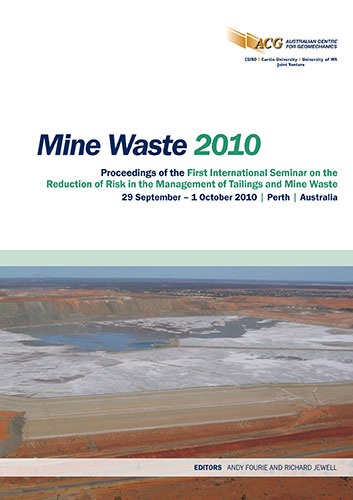Innovative expansion of a large centreline constructed tailings storage facility in a seismically-active area

|
Authors: Morrison, KF; Johnson, JM; Augello, AJ; Doughty, B |
DOI https://doi.org/10.36487/ACG_rep/1008_18_Morrison
Cite As:
Morrison, KF, Johnson, JM, Augello, AJ & Doughty, B 2010, 'Innovative expansion of a large centreline constructed tailings storage facility in a seismically-active area', in R Jewell & AB Fourie (eds), Mine Waste 2010: Proceedings of the First International Seminar on the Reduction of Risk in the Management of Tailings and Mine Waste, Australian Centre for Geomechanics, Perth, pp. 205-215, https://doi.org/10.36487/ACG_rep/1008_18_Morrison
Abstract:
The Bruno Creek Tailings Impoundment, located in seismically-active central Idaho, United States of America, retains tailings behind one of the tallest centreline-raise cyclone tailings sand dams in the world. From a current height of approximately 170 m, the dam is proposed to be raised to a height of nearly 230 m based on projected life of mine (LOM) ore reserves. An alternatives evaluation indicated the preferred option for tailings expansion is to raise the existing facility using the centreline raise method over most of the dam alignment, but modifying the design to employ a partial realignment of the dam crest at the left abutment. This change will result in a length of the previously centreline-raised dam being constructed over an existing tailings beach. The design also includes steepening of the downstream dam slopes, as well as construction of a raise on the existing rock toe dam to limit downstream impacts. This paper presents the geotechnical design aspects of the project, focusing on the site seismicity and assessment of dynamic liquefaction potential.
References:
Bray, J.D., Rathje, E.M., Augello, A.J. and Merry, S.M. (1998) Simplified Seismic Design Procedure for Lined Solid-
Waste Landfills, Geosynthetics International Journal, No. 1.
Idaho Administrative Code (IAC) (2010a) Safety of Dams Rules, IDAPA 37 Title 03 Chapter 06 (37.03.06).
Idaho Administrative Code (IAC) (2010b) Mines Tailings Impoundment Structures Rules, IDAPA 37 Title 03 Chapter
05 (37.03.05).
International Committee on Large Dams (ICOLD) (2002) Seismic Design and Evaluation of Structures Appurtenant to
Dams, Guidelines, Bulletin 123.
Jeffries, M.G. and Been, K. (2006) Soil Liquefaction – A Critical State Approach, Taylor and Francis, London.
Jeffries, M.G. and Davies, M.P. (1993) Use of CPT Values to Estimate Equivalent SPT N60, ASTM Geotechnical
Testing J., Vol. 16, No. 4, pp. 458–467.
NCEER (1997) Contributions from Youd, T.L., Idriss, I.M., Andrus, R.D., Arango, I., Castro, G., Christian, J.T.,
Dobry, R., Finn, W.D.L., Harder, L.F., Hynes, M.E., Ishihara, K., Koester, J., Liao, S., Marcuson III, W.F.,
Martin, G.R., Mitchell, J.K., Moriwaki, Y., Power, M.S., Robertson, P.K., Seed, R. and Stokoe, K.H., Summary
Report of the 1996 NCEER Workshop on Evaluation of Liquefaction Resistance, Salt Lake City, Utah.
NRC (1985) Liquefaction of Soils During Earthquakes, National Academy Press, Washington D.C.
Richins, W., Pechman, J., Smith, R., Langer, C., Goter, S., Zollweg, J. and King, J. (1987) The 1983 Borah Peak, Idaho,
earthquake and aftershocks, Bulletin of the Geological Society of America, Vol. 77, pp. 694–723.
Robertson, P.K. (2010) Evaluation of Flow Liquefaction and Liquefied Shear Strength Using the Cone Penetration Test,
J. Geotechnical and Geoenvironmental Engineering, Vol. 136, No. 6, ASCE, pp. 842–853.
Robertson, P.K. and Wride, C.E. (1998) Evaluating Cyclic Liquefaction Potential Using the CPT, Canadian
Geotechnical Journal, Vol. 35, No. 3, pp. 442–459.
SRK (1995) Embankment Seepage and Stability Issues, Technical memorandum from R. Dorey to B. Doughty
(TCMC).
Stark, T.D. and Olson, S.M. (1995) Liquefaction Resistance Using CPT and Field Case Histories, Journal of
Geotechnical Engineering, Vol. 121, No. 12, ASCE, pp. 856–869.
Tsukamoto, Y., Ishihara, K., Nakazawa, H., Kamada, K. and Huang, Y. (2002) Resistance of Partially Saturated Sand to
Liquefaction with Reference to Longitudinal and Shear Wave Velocities, Soils and Foundations, Vol. 42, No. 6,
pp. 93–104.
Ulrich, B.F. and Fourie, A.B. (2003) Assessment of the potential for static liquefaction of a tailings dam using
laboratory and field testing, Tailings and Mine Waste ’03, in Proceedings Tenth International Conference on
Tailings and Mine Waste, 12–15 October 2003, Vail, Colorado, USA, A.A. Balkema Publishers.
Youd, T.L., Idriss, I.M., Andrus, R.D., Arango, I., Castro, G., Christian, J.T., Dobry, R., Liam Finn, W.D., Harder Jr.,
L.F., Hynes, M.E., Ishihara, K., Koester, J.P., Liao, S.S.C., Marcuson III, W.F., Martin, G.R., Mitchell, J.K.,
Moriwaki, Y., Power, M.S., Robertson, P.K., Seed, R.B. and Stokoe II, K.H. (2001) Liquefaction Resistance of
Soils: Summary Report from the 1996 NCEER and 1998 NCEER/NSF Workshops on Evaluation of
Liquefaction Resistance of Soils, Journal fo Geotechnical and Geoenvironmental Engineering, Vol. 127, No. 10,
ASCE.
Innovative expansion of a large centreline constructed tailings storage facility in a K.F. Morrison et al.
seismically-active area
216 Mine Waste 2010, Perth, Australia
© Copyright 2025, Australian Centre for Geomechanics (ACG), The University of Western Australia. All rights reserved.
View copyright/legal information
Please direct any queries or error reports to repository-acg@uwa.edu.au
View copyright/legal information
Please direct any queries or error reports to repository-acg@uwa.edu.au